I had a very pleasant Sunday.
First, a quiz. Who can say what that object is. Yes, we know that the statue is St. Philomena.
After the Sunday Masses, I went with His Hermeneuticalness to Chislehurst to meet our friend Fr. Brigg’s the parish priest. In the cemetery of his parish is the grace of the late and great Michael Davies, of happy memory.
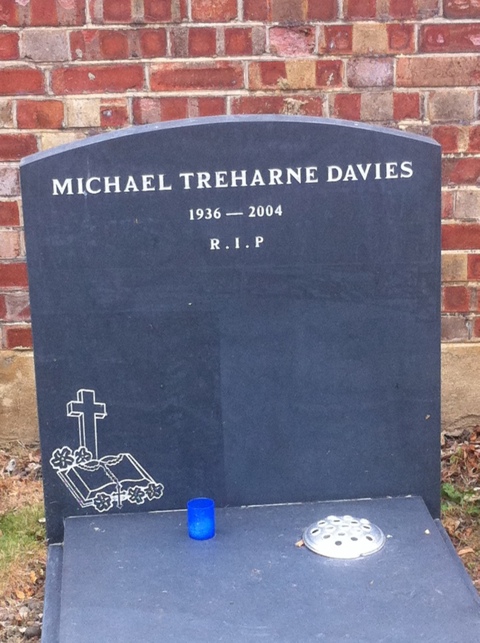
We went to a nearby golf course for lunch, a fine carvery. The house belonged to Napoleon III.
One side of the table!
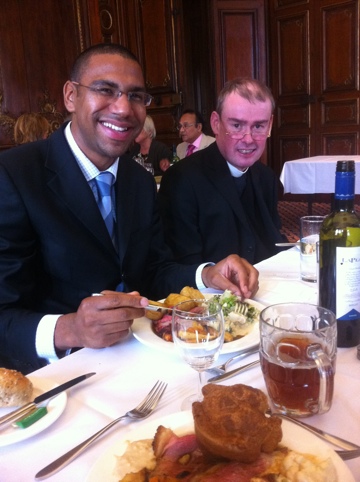
There is a copy of Napoleon’s death certificate on display.
Fr. Briggs before the nice facade. There are perks to being the parish priest.
A nice day.

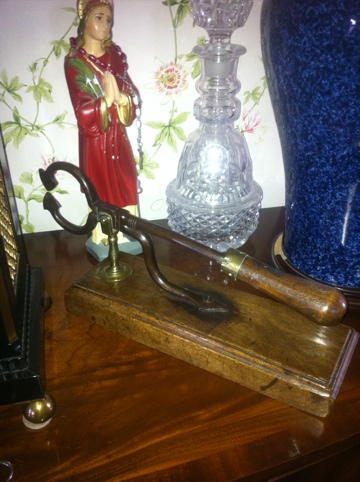
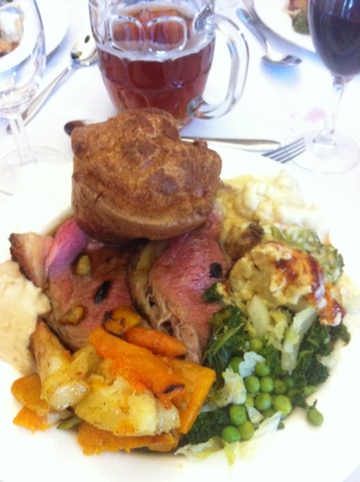

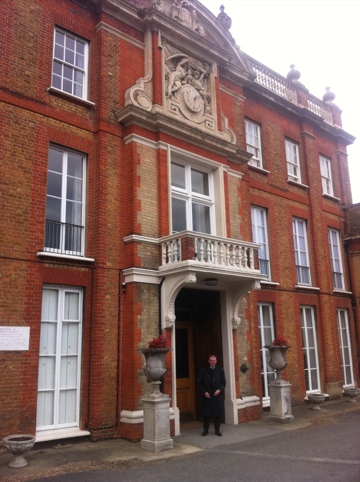

































God bless Michael, one of my heroes.
Is it a sugar cutter?
It’s a tongue extractor; especially helpful for those of us whose tastebud-holders won’t be turning into silver and will be requiring sweet pickling instead.
Also handy go yanking pigs’ tongues when making tongue and heart salami.
and, just because I am (or was) a teacher, here is more on the subject. People might not know from where the term “sugar loaf” comes ….
In another context (without the saintly statue), that device doesn’t look nice at all. Something about it says: Inquisition.
Nose pincers for heretic Catholics?
Correction: heretical Catholics.
The object is a cut or molded glass decanter with a ground glass stopper, probably no longer used because it has a high lead oxide content.
Ooooooooh, I know the answer to this one…. pick me, pick me… *waves hand frantically in the air*
;-p
A crystal decanter, a blue vase, and a jar opener.
Sugar nippers. For cutting pieces off your loaf of sugar. Oh, it comes in bags now, all granulated and flowing nicely.
For those who might misunderstand – the death certificate is that of Napoleon III who died at Chislehurst in 1873 and is now buried with his wife Eugenie in the Imperial Crypt at St. Michael’s Abbey, Farnborough.
“late great” indeed! I have read most of his works, but his Eternal Sacrifice is most relevant in our modernist age, especially for priests. The Mass IS NOT a meal but a Sacrifice, equal to that on Calvary, but unbloody.
The sooner we get back to that Truth, the sooner we’ll wean ourselves from abuse after abuse in Liturgy.
[Mass is certainly the Sacrifice of Calvary renewed. Mass is also the Last Supper renewed. It is Sacrifice and it is “meal”, though that is a low word. Banquet is perhaps more appropriate, because of the eschatological overtone of the word, pointing to the fulfillment of we will experience in heaven even as it simultaneously points back to the Last Supper. O Sacrum Convivium… O sacred banquet! in which Christ is received, the memory of his Passion is renewed, the mind is filled with grace, and a pledge of future glory to us is given. Both/and, not either/or. But in this vale of tears it seems to me correct to stress the Sacrificial dimension without losing sight of the Convivium.]
The Mass IS NOT a meal but a Sacrifice.
Actually the Mass is a meal AND a sacrifice. For what other reason do we say “happy are those who are called to the supper of the Lamb” before eating Christ’s body and blood? To think otherwise is to leave out half of the Church’s teaching on the Mass.
Sugar nips: Quite a neat historical item.
http://damselsinregress.files.wordpress.com/2010/12/sugar-nips.jpg
Who is Michael Davies? What is the metal object on the right side of the tomb?
Disturbed Mary, please Google “Michael Davies” and search for his books on Amazon. An orthodox Catholic he was.
For flowers.
What a pity the meat wasn’t cooked before serving! yuk
I can’t answer the quiz question, I’m too distracted by the sight of that scrumptious-looking Yorkshire pudding!
For scoring and cutting off the end of a bottle of port.
I believe the election of Pope Benedict XVI and Summorum Pontificum as both attributable to the intercession of Michael Davies. Two miracles, perhaps, towards the cause for his canonization.
I hope those were whole cloves of garlic.
Seems like a fabulous feast.
acardnal: A brief video of Michael Davies. Note what the commenter/uploader says about giving a taste of his style and humor http://www.youtube.com/watch?v=ouWVnDKOFR4
Here’s the whole (2 hrs 28 min) Michael Davies lecture! http://www.youtube.com/watch?v=9bmiAex-FFQ
Lori Pieper says:
The Mass IS NOT a meal but a Sacrifice.
Actually the Mass is a meal AND a sacrifice. For what other reason do we say “happy are those who are called to the supper of the Lamb” before eating Christ’s body and blood? To think otherwise is to leave out half of the Church’s teaching on the Mass.
1. The concept of the Eucharist as a meal refers to it being a memorial of the Last Supper. It comes from Protestantism, which denied that the Eucharist is a Sacrifice, a memorial of Christ’s Passion and Death.
2. The phrase Cena Agni (Supper of the Lamb) is found in the Apocalypse (19:7-10) and does not refer to a past event (the Last Supper) but rather a future one, the banquet of the marriage of the Lamb with His Church that will occur at the end of time.
3. You might want to consult the catechism, which makes no mention of the Eucharist as a meal.
Ah, Sunday roast!!
robtbrown:
The catechism makes no mention of the Eucharist a a meal? Just which catechism are you referring to? The Catechism of the Catholic Church, in its article on the Eucharist, after discussing the Eucharist as sacrifice in chapter 5, then goes to Chapter VI. Note the title:
“VI. The Paschal Banquet
1382 The Mass is at the same time, and inseparably, the sacrificial memorial in which the sacrifice of the cross is perpetuated and the sacred banquet of communion with the Lord’s body and blood. But the celebration of the Eucharistic sacrifice is wholly directed toward the intimate union of the faithful with Christ through communion. To receive communion is to receive Christ himself who has offered himself for us.
1383 The altar, around which the Church is gathered in the celebration of the Eucharist, represents the two aspects of the same mystery: the altar of the sacrifice and the table of the Lord. This is all the more so since the Christian altar is the symbol of Christ himself, present in the midst of the assembly of his faithful, both as the victim offered for our reconciliation and as food from heaven who is giving himself to us.”
I can understand someone saying that at the time of the Protestant Reformation, in response to Protestants who saw the Eucharist only as a meal, the Church began to stress that it was a sacrifice more than a meal, but to suggest that the Church has never regarded the Eucharist as a meal – I think all the evidence is against that.
I can see someone saying that trendy “spirit of Vatican II” types have lost all sense of the Mass as a sacrifice, don’t believe in the Real Presence, see the Eucharist only as a community supper, etc., but that is no excuse to throw the baby out with the bath water and to deny altogether that the Eucharist is a meal.
Of course the fulfillment of the Lamb’s Supper comes at the end of time in heaven. But I have always been taught that the Eucharist is a foretaste of that supper.
Do you have some documents from the Church supporting your view?
For the record and back to the original question, I responded “sugar cutter” rather than nipper as the nipper was traditionally movable, against a table or in the hand, rather than stationary, but I think different Europeans called them either nippers or cutters. The sugar loafs were sometimes quite large, if poor sugar, the smaller ones being a better grade of sugar. If that was a family treasure, someone in the family had a very comfortable lifestyle. The careful Scandinavian ones can be put in boxes, to save bits, but the British ones are more elegant. Note that the great mountain in Rio is named after the shape of the sugar loaf. I can’t imagine cutting sugar everyday….but then, I hardly eat it except in very strong coffee, which I take black.
Sancta Filumena, ora pro nobis.
Napoleon III’s death certificate.
I guess it is quite unusual in UK to read on a death certificate, in the voice “Occupation” : “Emperor”.
Anyways more unusual than “king”
With regard to the whole Mass is a meal issue…It is first a sacrifice. It must be. It can be nothing other than that. To deny that is to deny the end of the Mass. I don’t think that anyone HERE is doing that. BUT, the meal aspect is an allusion to what will be. In heaven, those who are there worship at the heavenly banquet. The meal is a symbol on earth, there is nothing concrete in the present, but a pointing to what will be in the future.
We know that the Mass is a memorial of the Last Supper, but that doesn’t mean that it is properly a meal. This is a clear change in theology, after Vatican Council II. Traditional Catholic teaching can be found in the Council of Trent which says:
“He, therefore, our God and Lord, though He was about to offer Himself once on the altar of the cross unto God the Father, by means of his death, there to operate an eternal redemption; nevertheless, because that His priesthood was not to be extinguished by His death, in the last supper, on the night in which He was betrayed,–that He might leave, to His own beloved Spouse the Church, a visible sacrifice, such as the nature of man requires, whereby that bloody sacrifice, once to be accomplished on the cross, might be represented, and the memory thereof remain even unto the end of the world, and its salutary virtue be applied to the remission of those sins which we daily commit,–declaring Himself constituted a priest for ever, according to the order of Melchisedech, He offered up to God the Father His own body and blood under the species of bread and wine; and, under the symbols of those same things, He delivered (His own body and blood) to be received by His apostles, whom He then constituted priests of the New Testament; and by those words, Do this in commemoration of me, He commanded them and their successors in the priesthood, to offer (them); even as the Catholic Church has always understood and taught. (CT XXII, 1)”
It is properly called food, because it is spiritual food, but not food in the sense that a meal is food. It sustains us not in a temporal way, but in a spiritual way. We are not looking at the Mass as a meal, but rather as the confection of the Sacrament (The Eucharist) and the unbloody sacrifice of Calvary.
So, the Eucharist does three things; 1. The Passion of our Lord. 2. Heavenly Grace, which is what nurtures our soul, and 3. the foreshadowing of our heavenly joy. (Catechism of the Council of Trent, On the Eucharist)
Our existence in heaven will be a participation in the heavenly worship. The Banquet of the Lamb. The Mass on Earth is a foreshadowing of that, while at the same time, first as an unbloody sacrifice of Christ and only then a memorial of the Last Supper, which imparts heavenly grace.
But at no time should the Mass be thought of as a meal, in concrete terms. The meal aspect is merely a symbol and a foreshadowing. For without the sacrifice, there can be no Mass. Also, notice that at no point does your quoting of the new CCC state that there is a meal, but rather a banquet (as Fr. Z so aptly put it). There is a difference theologically. I’ll leave that to you to research and respond.
Nice house-and great dinner!
That object next to St. Philomena’s statue looks like an instrument of torture. ; )
God bless Michael Davies, a great servant of God…eternal rest grant unto him, O Lord, and let perpetual life shine upon him. Amen.
Only just found this but those are sugar cutters. Also you’d need some kind of tray to catch the sugar as you cut it.
The tip that the death certificate was for Napoleon III is that the occupation was Emperor of the French, rather than Emperor of France.
In Colonial North America, Sugar loaves came wrapped in indigo paper, which was recycled by soaking in water, and using it to dye fabrics. Or so I have read.
Semper Fi!
DisturbedMary,
Thanks for asking and thanks for posting, am watching the lecture now!
If those making a covenant don’t eat the sacrificed critters involved, the covenant does not take effect. If those holding a sacrifice of animals don’t eat any of the sacrificial meat, no sacrifice takes place.
So if you think Mass is a sacrifice, you have to believe that chowing down is involved, because otherwise it’s no sacrifice at all. So come on, people, and quit throwing out the sacrificial Babe with the “I hate Vatican II and the word ‘meal’ ” bathwater.
Ed the Roman,
Napoleon I also went by Emperor of the French, not Emperor of France
Suburbanbanshee, thanks a lot for the support.
I certainly never meant to say that the Eucharist was an “ordinary” meal. It’s probably correct to stress the “banquet” because of its connection with the heavenly banquet. I didn’t know people attached such great importance not using the word “meal.” I was just amazed at how peremptory the original poster (Maltese) was in seeming to deny ALL significance to the Eucharist as food.
The elements we eat are certainly concrete ones; as in all the sacraments, here too earthly things are made a vehicle participation in heavenly reality. So some of the language people have used here about the Eucharist seems weirdly Gnostic to me.
At any rate, when I wrote those comments last night I was tired and testy; I had spent the whole day working on my tax return (I asked for an extension in the spring). I hope what I said didn’t give offense.
Forget the other stuff, Fr Z, your timing on the St. Philomena statue could not have been more timely, as my maternal Grandmother, Philomena Nord, passed away on Oct 17 in the early morning, at the age of 91, with all of her 12 children having been in her presence in the preceding days, and I was blessed to spend a couple of hours there myself. Please remember her in your prayers. Requescat in pace.
Lori Pieper says,
Of course the fulfillment of the Lamb’s Supper comes at the end of time in heaven.
Excuse the delay.
1.The question is what should be the form (i.e. structure) of the Eucharist. Should it be a meal? I think not. Many, including Guardini thought, the structure was that of a meal, with the Sacrifice being its content. JRatzinger has rejected this approach. He thinks the content should determine the structure: The Eucharist is not the continuation of the Passover Meal, i.e. a Christianized version of it.
2.That the consecrated species are consumed does not make it a meal. Chewable vitamins are eaten, and cough syrup is drunk. The consumption of neither can be considered a meal.
3.You might look at Ratzinger’s The Spirit of the Liturgy. I have lent my copy to a priest, but if memory serves, on p 78 (lower half of the page) he explicitly says the Eucharist is not a meal.
4.It is not correct that the fulfillment of the Lamb’s Supper comes at the end of time. As I noted before, it is from the last book. The Lamb’s Supper is at the end of time. Words like “banquet” do not refer to the Last Supper but rather the eschatological Lamb’s Supper of the marriage feast of Christ and His Church.
5.The Eucharist is not a memorial of the Last Supper. Historically, the couplet used to describe it is that it is a memorial of Christ’s Passion and Death instituted at the Last Supper.
6.There is a triple reference with every Sacrament: Past, Present, and Future. The past reference of the Eucharist is Christ’s Passion and Death—not the Last Supper.
7.It is significant to the nature of the Eucharist, thus how it is to be celebrated, that Christ instituted it before His death on the cross. IMHO, if He had instituted it after His Resurrection, then it could be considered a meal. Someday, God willin’ and the crick don’t rise, I’m going to write an article on the timing of the Last Supper.